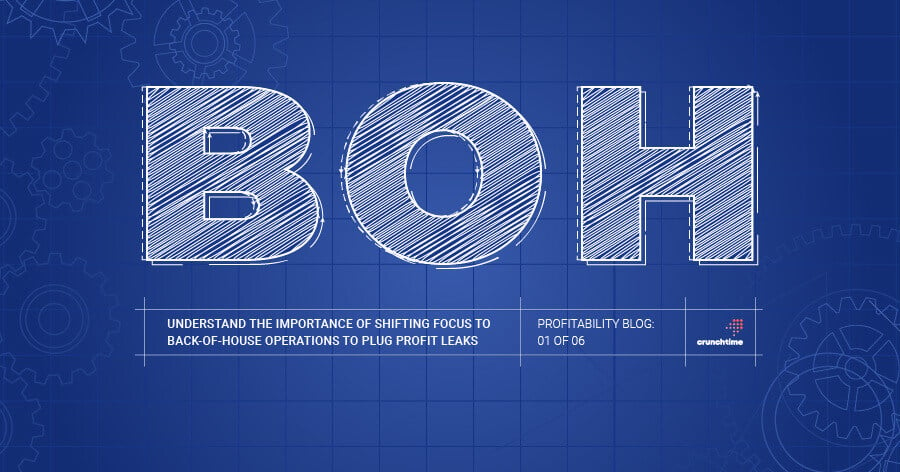
- Home
- Crunchtime Blog
- A Profit-First Approach to Resilient Restaurant Operations [Part 1]

A Profit-First Approach to Resilient Restaurant Operations [Part 1]
This is the first installment of a six-part series on boosting profitability and building resilience in your restaurant operations. To kick things off, we’ll explore the importance of shifting focus to back-of-house (BOH) operations to plug the leaks in your profit bucket.
We’ve been here before. When the COVID-19 pandemic disrupted everything, quarantine restrictions forced everyone to rethink their operations. The brands that weathered the storm best were the ones that doubled down on infrastructure and back-of-house operations. That mindset still matters, and that same playbook applies now: In unpredictable times, operational readiness is everything.
As we navigate abrupt changes and uncertainties in tariffs, every challenge for multi-unit restaurant operators hits harder. The pressure is on to reduce costs and maintain profitability, and when margins are tighter than they usually are, the focus often shifts to increasing sales. It’s a natural reaction, but there’s a fundamental flaw in this approach: It ignores the biggest source of profit leaks—your back-of-house (BOH) operations.
While front-of-house (FOH) solutions have value, they don’t address the underlying inefficiencies silently draining profitability from the BOH. In an industry with razor-thin margins, any small leak can completely eliminate a sales gain. Consider this: Even a 10% increase in sales won’t help if food waste, labor inefficiencies, and operational missteps are cutting deep into those gains. If your BOH operations are inefficient, every extra dollar in sales could be offset by rising costs you aren’t tracking.
If FOH tech isn’t the magic fix, where should operators focus?
The answer lies in tightening BOH controls. Here are the biggest culprits of wasted profit:
- Labor Mismanagement: Over-scheduling, understaffing, and inconsistent shift planning drive up labor costs and impact service quality.
- Lack of Operational Consistency: Without clear, repeatable processes, every location runs slightly differently, leading to costly inconsistencies.
- Inaccurate Inventory Tracking: Poor inventory visibility leads to over-ordering, stock shortages, and excess food waste.
- Poor Training and Inefficient Execution: A workforce that isn’t properly trained leads to mistakes, inefficiencies, and increased turnover.
The reality is that these challenges don’t just hurt one location—they multiply across every unit in your system. What seems like a minor issue in one restaurant becomes a major financial drain when spread across dozens or hundreds of locations.
Smart operators understand that fixing BOH inefficiencies has a direct impact on profitability. As reported by NRN, CFOs are prioritizing cost control through strategies such as labor forecasting, optimizing menu pricing, and streamlining outdated services, while CEOs and COOs have become more focused on investing in and adopting technology to improve and optimize efficiencies. According to Wray Executive Search, adaptability, innovation, and a commitment to both operational excellence and talent development will be critical areas of focus in the current environment.
As a result, investing in operational excellence pays for itself in multiple ways:
- Lower Costs: Reducing food waste, optimizing labor, and improving workflows mean leaner operations and fewer unnecessary costs.
- Fewer Errors, Higher Efficiency: Standardized and automated BOH processes reduce mistakes and help prevent employee churn, saving both time and money.
- Higher Profit Margins: Every dollar saved in the BOH contributes directly to the bottom line, without the uncertainty of relying solely on increased sales.
- Better Customer Experience: A well-run BOH ensures food is prepped correctly, orders go out on time, and the front-of-house runs smoothly.
As we head into what could be another unpredictable stretch, the time to future-proof your ops is now.
This six-part series will further explore key areas—labor, operations execution, inventory, and training—to show how optimizing BOH operations leads to long-term success. Stay tuned for part two, and in the meantime, get a head start by downloading our Measuring What Matters ebook to learn how top restaurant brands track and improve their operational efficiency.
Share this post
Related


4 Common Inventory and Food Cost Challenges that Stifle Restaurant Growth



